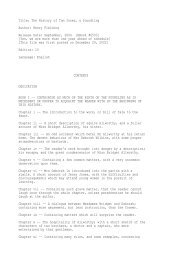Click to download PDF version: 3.87MB - Global Grey
Click to download PDF version: 3.87MB - Global Grey
Click to download PDF version: 3.87MB - Global Grey
Create successful ePaper yourself
Turn your PDF publications into a flip-book with our unique Google optimized e-Paper software.
176 At the Back of the Black Man's Mind By R. E. Dennett<br />
EGBAW is a state of being cleaned as corn is when its husks are scraped off; so that the<br />
idea of scraping is associated with the third month also. Thus we have EHA three<br />
opposed <strong>to</strong> EVA, two both with much the same symbolic meaning. EHA, however, in the<br />
word ten and three or thirteen appears as ERA, and ERA means father.<br />
We may then conclude that in EVA and EHA we have given <strong>to</strong> us the maternal and<br />
paternal principles, found under the symbolic names of the second and third months, in<br />
XIVILI, i.e., the deep of fresh water and the deep of salt water.<br />
4. During the fourth month they clear the ground, thus getting it ready for planting the<br />
yams. This action they term EKWEN; the number four is ENA, and means that which<br />
contains the power of spreading.<br />
5. ISAN, or five, means the act of springing. Thus these two months are connected with<br />
planting in the earth.<br />
6. During the sixth month the people drive poles (IFIEMA) in<strong>to</strong> the ground near <strong>to</strong> their<br />
yams, so that the yam vines may creep up them. Now the word for six is IHAN, and that<br />
means the act of being entangled. This is the month of marriage following that of love,<br />
the spring.<br />
7. During the next month they keep on putting poles in the ground. The word for seven<br />
being (3 + 4) IH'INAW, signifying the act of being entangled and spreading. This is much<br />
the same meaning as that of sambuade, or seven, in the Kongo.<br />
8, 9, and 10. Then for three months or so they keep on weeding their plantations,<br />
EKBONA NAGWINIMU:<br />
8 = INENE the act of much spreading (conception).<br />
9= IHINI the act of having fruit (germination).<br />
10= IGBE the act of being heavy (pregnancy).<br />
11. Six months after planting, or the eleventh month, the yams known as EMAWWE are<br />
ready, and 11 is OWARA (i.e., first being or first substance), the second month of<br />
pregnancy. Harvest, weight, pregnancy have been also shown <strong>to</strong> be associated with the<br />
tenth and eleventh months of the Bavili.<br />
12. During the twelfth month the IKME yams are ready, and 12, or IWE'YA, might be<br />
termed maternal weight or travail.<br />
13. During the thirteenth month the Bini finally harvest the yams called IGULWA. The<br />
number 13 is called IWE'RA, or paternal weight, the second month of travail. The<br />
meaning conveyed by these numbers 12 and 13 agrees with the Bavili twelfth and<br />
thirteenth months.<br />
www.globalgrey.co.uk
















